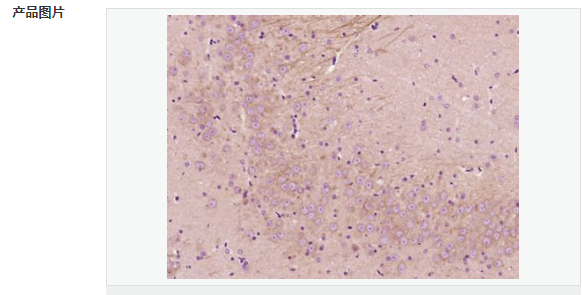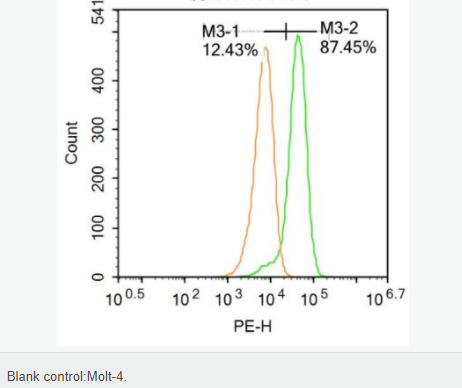
货号
产品规格
售价
备注
BN41711R-50ul
50ul
¥1486.00
交叉反应:Human,Rat(predicted:Mouse) 推荐应用:IHC-P,IHC-F,IF,Flow-Cyt,ELISA
BN41711R-100ul
100ul
¥2360.00
交叉反应:Human,Rat(predicted:Mouse) 推荐应用:IHC-P,IHC-F,IF,Flow-Cyt,ELISA
BN41711R-200ul
200ul
¥3490.00
交叉反应:Human,Rat(predicted:Mouse) 推荐应用:IHC-P,IHC-F,IF,Flow-Cyt,ELISA
| 英文名称 | NFAT2 |
| 中文名称 | 活化T细胞核因子1蛋白抗体 |
| 别 名 | NFAT2; MGC138448; NF ATc; NF ATc1; NFAT 2; NFATc1; NFAT transcription complex cytosolic component; NFATC 1; NFATc; NFATc1; Nuclear factor of activated T cells cytoplasmic 1; Nuclear factor of activated T cells cytoplasmic calcineurin dependent 1; Nuclear factor of activated T cells cytosolic component 1; NFAC1_HUMAN. |
| 研究领域 | 细胞生物 免疫学 神经生物学 信号转导 细胞凋亡 |
| 抗体来源 | Rabbit |
| 克隆类型 | Polyclonal |
| 交叉反应 | Human, Rat, (predicted: Mouse, ) |
| 产品应用 | ELISA=1:5000-10000 IHC-P=1:100-500 IHC-F=1:100-500 Flow-Cyt=1ug/test IF=1:100-500 (石蜡切片需做抗原修复) not yet tested in other applications. optimal dilutions/concentrations should be determined by the end user. |
| 分 子 量 | 101kDa |
| 细胞定位 | 细胞核 细胞浆 |
| 性 状 | Liquid |
| 浓 度 | 1mg/ml |
| 免 疫 原 | KLH conjugated synthetic peptide derived from human NFATc1:601-716/716 |
| 亚 型 | IgG |
| 纯化方法 | affinity purified by Protein A |
| 储 存 液 | 0.01M TBS(pH7.4) with 1% BSA, 0.03% Proclin300 and 50% Glycerol. |
| 保存条件 | Shipped at 4℃. Store at -20 °C for one year. Avoid repeated freeze/thaw cycles. |
| PubMed | PubMed |
| 产品介绍 | The product of this gene is a component of the nuclear factor of activated T cells DNA-binding transcription complex. This complex consists of at least two components: a preexisting cytosolic component that translocates to the nucleus upon T cell receptor (TCR) stimulation, and an inducible nuclear component. Proteins belonging to this family of transcription factors play a central role in inducible gene transcription during immune response. The product of this gene is an inducible nuclear component. It functions as a major molecular target for the immunosuppressive drugs such as cyclosporin A. Multiple alternatively spliced transcript variants encoding distinct isoforms have been identified for this gene. Different isoforms of this protein may regulate inducible expression of different cytokine genes. [provided by RefSeq, Jul 2013] Function: Plays a role in the inducible expression of cytokine genes in T-cells, especially in the induction of the IL-2 or IL-4 gene transcription. Also controls gene expression in embryonic cardiac cells. Could regulate not only the activation and proliferation but also the differentiation and programmed death of T-lymphocytes as well as lymphoid and non-lymphoid cells.Required for osteoclastogenesis and regulates many genes important for osteoclast differentiation and function. Subunit: Member of the multicomponent NFATC transcription complex that consists of at least two components, a pre-existing cytoplasmic component NFATC2 and an inducible nuclear component NFATC1. Other members such as NFATC4, NFATC3 or members of the activating protein-1 family, MAF, GATA4 and Cbp/p300 can also bind the complex. NFATC proteins bind to DNA as monomers. Subcellular Location: Cytoplasm. Nucleus. Cytoplasmic for the phosphorylated form and nuclear after activation that is controlled by calcineurin-mediated dephosphorylation. Rapid nuclear exit of NFATC is thought to be one mechanism by which cells distinguish between sustained and transient calcium signals. The subcellular localization of NFATC plays a key role in the regulation of gene transcription. Tissue Specificity: Expressed in thymus, peripheral leukocytes as T-cells and spleen. Isoforms A are preferentially expressed in effector T-cells (thymus and peripheral leukocytes) whereas isoforms B and isoforms C are preferentially expressed in naive T-cells (spleen). Isoforms B are expressed in naive T-cells after first antigen exposure and isoforms A are expressed in effector T-cells after second antigen exposure. Post-translational modifications: Phosphorylated by NFATC-kinase; dephosphorylated by calcineurin. Similarity: Contains 1 RHD (Rel-like) domain. SWISS: O95644 Gene ID: 4772 Database links: Entrez Gene: 4772 Human Entrez Gene: 18018 Mouse Omim: 600489 Human SwissProt: O95644 Human SwissProt: O88942 Mouse Unigene: 534074 Human Unigene: 701518 Human Unigene: 329560 Mouse Unigene: 229098 Rat Important Note: This product as supplied is intended for research use only, not for use in human, therapeutic or diagnostic applications. |

